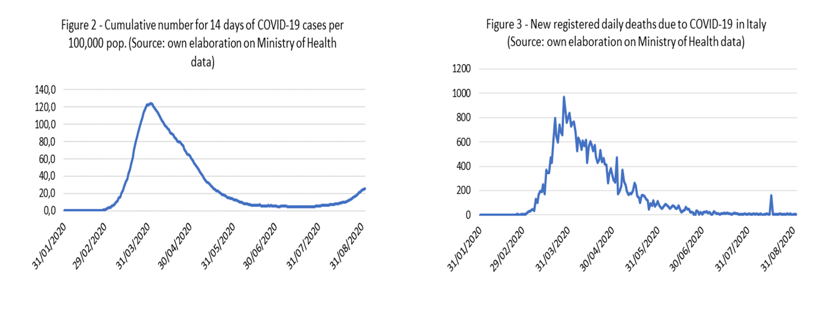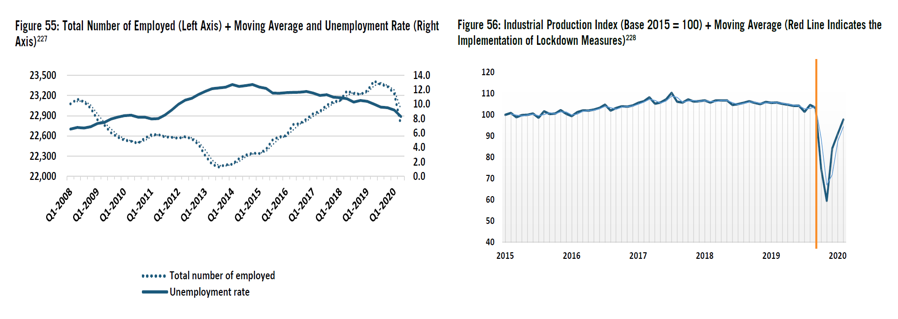The Italian Response to the COVID-19 Pandemic – Case study by Competere and I-ComGTIPA PERSPECTIVE ON COVID-19 - OCTOBER 2020
The Italian Response to the Coronavirus Pandemic (COVID-19)
By Pietro Paganini, Co-Founder and Curiosity Officer; Giacomo Bandini, Director General; and Stefano Sartorio, Research Analyst and Project Manager, Competere with Eleonora Mazzoni, Director, Innovation Department, I-Com
DOWNLOAD AND READ THE CASE STUDY ON ITALY >>
Summary
The COVID-19 (coronavirus) pandemic that emerged at the start of 2020 has impacted the global economy and public health to an unprecedented extent.
This study on Italy, authored by Competere and Istituto per la Competitività (I-Com), is part of an anthology that analyzes and compares the economic and public health impact and policy responses of 20 nations and regions—Argentina, Australia, Bangladesh, the California Bay Area, Chile, Colombia, the European Union (EU), Germany, Greece, Honduras, Indonesia, Italy, Jordan, Korea, Latin America, Mexico, Poland, South Africa, the United Kingdom, and the United States—to the coronavirus pandemic. The full report is published by the Global Trade and Innovation Alliance.
For each nation covered, this report examines the public health impact of the coronavirus in terms of infections, fatalities, and recoveries and documents public health responses nations have taken, including everything from diagnostic and testing approaches, to the preparations of hospitals and intensive care unit (ICU) beds, to nations’ efforts to develop coronavirus diagnostic kit and tests, therapeutic drugs, and vaccines to their plans to disseminate them to domestic and global audiences. Equally, the report examines the impact of the pandemic on nations’ economies in terms of GDP and employment effect, industrial output, and changes in trade flows. It considers both demand- and supply-side effects as well as business and consumer impacts. It also examines the economic and regulatory policy responses these nations have introduced in responding to the crisis.
The monographs were written over the late summer and early fall of 2020, and reflect the most-currently available data as of their time of authorship.
The Italian Case
The COVID-19 pandemic has rapidly spread in Italy, the first Western nation to be massively hit, and the country’s national health system has never had to face so hard a challenge. Meanwhile, the economic and social context was also put under great pressure. In the following paragraphs we analyze the Italian health and economic response to the COVID-19 crisis.
In a matter of weeks (from February 21 to March 22), Italy went from the discovery of the first official COVID-19 case to a government decree that essentially prohibited all movements of people within the whole territory, and the closure of all non-essential business activities.

Health response to contain Covid-19
Concerning the health response, the approaches taken by the Italian regional health systems to the COVID-19 emergency are of three types:
- A hospital-based model: Lombardia case / did not work
- A territorial-based model: Veneto case / reduced the number of hospitalized cases / worked
- A combined hospital-territorial model.
Lessons for decision makers:
- An effective response to the virus needs to be orchestrated as a coherent system of actions taken simultaneously
- Finding the right implementation approach requires the ability to quickly learn from both successes and failures and the willingness to change actions accordingly
- Proactivity and data collection are fundamental
The Economic Impact of Covid-19 in Italy
In order to stop the spread of COVID-19, the Italian government on 22 March 2020 published a decree suspending all industrial and commercial activities, with certain exceptions for “essential activities”. The suspension directive applied to the whole of Italy and was effective from 23 March until 3 May 2020.
After declining in the first quarter (-8.4 per cent compared with the previous year), industrial production registered another sharp fall in April (-19.1 per cent compared with the previous month), reflecting the lockdown of ‘non-essential’ activity. With the gradual easing of the lockdown, industrial activity began to grow again in May and June, (by 40 per cent compared with April), but still almost 25 per cent below the levels prior to the spread of the epidemic.
Epidemic affected particularly the demand for goods and services, as reported by most of the firms, both domestic and foreign. Furthermore, the obstacles to the procurement of raw materials and workforce availability were major factors of the production drop.
Employment is projected to decrease by about 12 per cent this year in terms of hours worked, and then to recoup about three quarters of the fall over the next two years. The number of persons in employment decreased by 500.000 units since February 2020 also due to the extensive use of wage supplementation. This appears has been massive in the second quarter of the year, involving about 3 million full-time equivalent employees.

The Government response
To counter economic downturns during the COVID-19 pandemic, Italian government issued three sets of measures through the Cura Italia Decree, the Liquidity Decree (Decreto Liquidità) and the Relaunch Decree (Decreto Rilancio) for an allocated amount of more than 450 billion euros.
Main measures implemented aimed primarily at:
- Increasing the financial capacity of the National Health System
- Supporting employment and workers income;
- Stimulating financial credit and loans through the banking system and the use of a central guarantee fund
The Governmente also implemented a system of tax credit to stimulate private investments.
Conclusions
- The political economy of the pandemic has proven rather complex. COVID-19 has brought about an unprecedented concentration of powers in the hands of the government. The role of the State in the economy, as regulator, owner, and facilitator, has grown in a matter of weeks, sometimes reflecting broader European trends.
- The policies implemented by the Italian government to contrast the negative impact of the pandemic aimed primarily at sustaining consumption and employment. Despite the (announced) intention of presenting a structural package of measures to relaunch investments in the country, the intervention on the supply-side relied mainly on credit guarantees and various tax measures.
- Innovation and technology, especially applied in education, were almost excluded by the major actions taken by the government.
- Finally, Italy’s role in the EU was also challenged by the reluctant position showed by the so called “frugal” countries (Netherlands, Austria, Denmark and Sweden) to extend mutual support to Italy. The agreement reached in the EU consists in around 200 billion funds in the next years, but we still have a long path ahead and the scenario remains uncertain with the second wave of pandemic.
COMPETERE AND I-COM CASE STUDIES
DOWNLOAD AND READ THE CASE STUDY ON ITALY >>
DOWNLOAD AND READ THE CASE STUDY ON THE EUROPEAN UNION >>
GTIPA PERSPECTIVES: COVID-19 IMPACTS ON PUBLIC HEALTH AND THE ECONOMY OF GTIPA MEMBER NATIONS
DOWNLOAD AND READ THE GTIPA ANTHOLOGY ON COVID-19 >>
ABOUT THE GLOBAL TRADE AND INNOVATION POLICY ALLIANCE
The Global Trade and Innovation Policy Alliance (GTIPA) is a global network comprising over 40 like-minded, independent think tanks that support greater global trade liberalization and integration and deplore trade-distorting “innovation mercantilist” practices, but yet believe that governments can and should play important and proactive roles in spurring greater innovation and productivity in their enterprises and economies. Member organizations advocate and adhere to research and policy consistent with a core Shared Statement of Principles. The Alliance gives world-class think tanks a space to collaborate on events, research, and reports while enjoying a platform that highlights and cross-pollinates member organizations’ work on trade, globalization, and innovation policy.


